Round The World and other travels
A frequent flyer's collection of trip diaries
This is: Round Ireland (2016-20)
Tralee - Limerick: End of Part 1
I had a nice breakfast at the Rose, served in a huge room that was nearly empty. The car park tended to confirm a very low occupancy rate. I left around 9:15 - it seemed to be standard operating procedure on this trip - and easily found the R551 for the 15-minute drive to Ardfert. It's only a village, yet I made two distinct stops there: one to see a ruined cathedral and one to see a ruined friary. Clearly, Ardfert was once an important ecclesiastical centre. The Norman-style cathedral was destroyed in the 17th century, but it was good to see evidence of much conservation work taking place during my visit. The 13th-century Franciscan friary, located on the edge of the village, was equally impressive. The friars were driven out in 1584 so that the building could be used as a barracks.
 |
 |
 |
 |
 |
 |
| ABOVE: In the centre of Ardfert, the ruins of its former cathedral | |||||
| BELOW: A short distance away, on the edge of the village, the ruined Franciscan friary | |||||
 |
 |
 |
 |
 |
 |
 |
 |
| The ruins of Carrigafoyle Castle | |
I continued my drive, passing through a number of small communities, the most memorably named of which was Ballybunion. In due course, I took a small side road to reach Carrigafoyle Castle, or at least what was left of it. Remarkably, this was my third ancient ruin of the morning. The castle, once called the Guardian of the Shannon, was besieged and attacked by British troops in 1580 as part of a wider effort to quell an Irish rebellion. On this day in 2016, it seemed to be under siege once more, this time from a loud and boisterous all-male group of Dutch tourists. It seemed to me that most of them - hopefully not the driver - had been on the sauce already, and I kept my distance rather than risk getting caught up in their laddish horseplay.
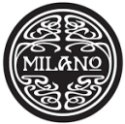 Continuing
my journey, I found that the R551 soon merged with the N69 to give a
relatively fast run into Limerick, where I parked at Harvey's Quay,
one of many available options for covered parking. There was a
branch of Milano (the brand used by Pizza Express in
Ireland) in the same block, so I had a nice, lighter-option lunch
there of a smaller than normal thin-crust pizza, combined with
salad.
Continuing
my journey, I found that the R551 soon merged with the N69 to give a
relatively fast run into Limerick, where I parked at Harvey's Quay,
one of many available options for covered parking. There was a
branch of Milano (the brand used by Pizza Express in
Ireland) in the same block, so I had a nice, lighter-option lunch
there of a smaller than normal thin-crust pizza, combined with
salad.
 |
LEFT and BELOW: On my way to King's Island, wishing it would brighten up a little |
 |
 |
Limerick (Irish: Luimneach), with a population of 96,000, is the third largest city in the republic and the fourth largest on the island of Ireland. It lies on the Shannon, at the point where the river becomes an estuary, and the historic part of the city is located on King's Island. With my midday hunger satisfied, I was ready to begin my explorations, and I got started by making my way to that very island. The weather looked cloudy and dull at this stage, but I couldn't decide whether it qualified as 'threatening'.
My first port of call was the historic cathedral of St Mary the Virgin. Founded in the twelfth century, the cathedral passed to the Church of Ireland at the time of the Irish Reformation. It is the oldest building in Limerick that is still in daily use. The nearby City Museum, situated in City Hall, provided a further point of interest, though not one that I was able to explore in detail on this short visit.
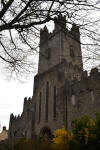 |
 |
 |
 |
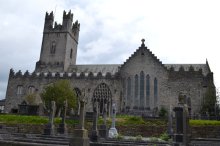 |
 |
 |
 |
 |
 |
 |
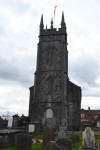 |
 |
 |
 |
When I was finished at the cathedral I walked
northwestwards along Nicholas Street towards King John's Castle.
Before exploring this, however, I crossed Castle Street to look at a
cluster of buildings (right) that included the former
Bishop's Palace and St Munchin's Church. (The latter, for some
reason, made me think of The Wizard of Oz!
![]() )
)
King John's Castle dates from the 13th century and is one of the best preserved Norman fortifications in Europe. It stands on King's Island adjacent to Thomond Bridge, on the site of a former Viking settlement.
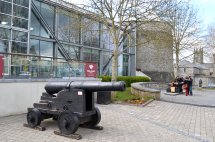 |
 |
 |
 |
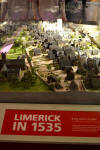 |
|
 |
 |
 |
|||
 |
 |
 |
 |
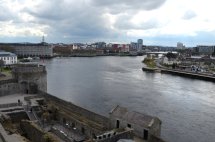 |
|
 |
 |
 |
 |
||
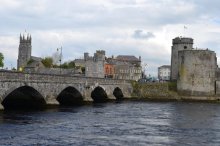 |
 |
 |
 |
 |
My tour of the castle complete, I returned to the car via Thomond Bridge, Clancy's Strand and Ennis Road. The weather had brightened up a little by this point, revealing glimpses of blue sky and allowing some decent riverside views to be appreciated in shades other than grey. I would soon drive to Limerick's Radisson Blu hotel on the western edge of the city, where as explained in the Hotels section of this trip report, I would spend a night that was unprecedented for its complete lack of any meaningful rest. The next day, in a semi-comatose state, I would turn in my trusty Astra at nearby Shannon Airport, fly back to Edinburgh and return home for a proper night's sleep.
But as Part 1 draws to a close, now seems an appropriate point at which to press the 'pause' button on my Round Ireland adventure. Please join me again, hopefully sometime during 2017, when I resume the journey at Shannon and work my way northwards up Ireland's wild Atlantic coast.